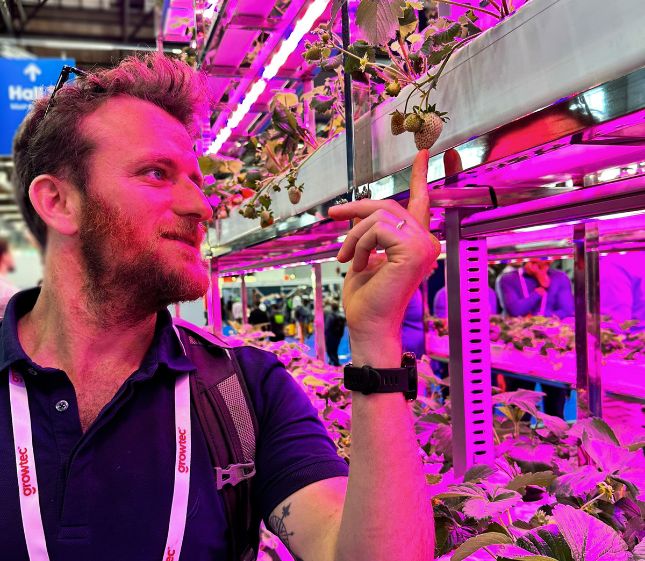Love strawberries? What if you could grow them year-round, right in your own home? Welcome to the world of indoor hydroponics, a soil-free cultivation method that allows you to harvest sweet, juicy strawberries regardless of the season. This blog post will guide you through the process of growing strawberries in a hydroponic system indoors. We’ll delve into the importance of temperature, humidity, and the impact of these factors on Soluble Sugar Content (SSC) – the key to your strawberries’ sweetness.
Temperature Requirements for Growing Strawberries Indoor:
Temperature plays a critical role in the growth and fruiting of strawberries. Optimal growth is maintained at day temperatures between 23–28°C, with an ideal night temperature between 5–10°C. Consistently maintaining these temperatures in your hydroponic system will help to prevent potential issues such as reduced crop yield, changes in fruit size and color, and disruptions to the photosynthesis process.
How Humidity affects Strawberry Growth:
Relative humidity is closely associated with temperature and directly impacts a plant’s water content, size, and bioactive component concentration. With strawberries, it’s important to strike a balance – too low humidity can lead to water stress, while too high humidity can foster the growth of fungal diseases. Aim for a relative humidity of around 50-70% for optimum strawberry health.
See How Growee Can Save You Time By Automating Your Plants Feeding
Water pH – Automated pH Up and Down Control
Nutrients Mixing – Automated Nutrient Dosing with Target EC / PPM Control.
Control From Anywhere – WiFi Connection and mobile App
Understanding Strawberry Sweetness the Impact of SSC
What’s better than biting into a ripe, sweet strawberry? The sweetness comes from Soluble Sugar Content (SSC), which is a measure of the sugars and other substances dissolved in the fruit’s cells. SSC can range from 4% to 11% in strawberries, depending on the variety and environmental conditions. Notably, temperatures above 25°C can reduce fruit set and decrease SSC, so it’s crucial to maintain optimal temperatures in your hydroponic system.

Common diseases that affect strawberries include:
- Botrytis (Grey Mold): This fungus thrives in high humidity and causes the strawberry plant’s leaves, flowers, and fruit to rot. Maintain adequate airflow and lower humidity levels to prevent this disease.
- Powdery Mildew: This appears as a white powdery substance on the plant’s surface. Reduce humidity and ensure proper ventilation to control the spread.
EC Levels and their Effects on Hydroponic Strawberry Yield
Electrical Conductivity (EC) is an essential metric in hydroponics that indicates the concentration of dissolved salts or nutrients in your water solution. Understanding and managing this factor is crucial because an excessive EC value can cause nutrient burn in strawberries, which affects their growth and overall yield.
Studies have shed light on how varying EC levels can impact strawberry growth, particularly in terms of root dry weight and fruit yield. The research found that the most favorable EC for strawberry growth was precisely 1.0 ms/cm. You might think that increasing the nutrient concentration, thereby raising the EC to 2.0 ms/cm, would boost growth, but contrary to this expectation, the results indicated a negative impact.
At an EC of 2.0 ms/cm, the root dry weight was notably lighter, signifying less robust root development. This had a knock-on effect on fruit yield, which was significantly lower compared to when strawberries were grown under lower EC values. Interestingly, this higher EC level didn’t lead to sweeter strawberries. Despite the increased nutrient concentration, the soluble solids content — which includes sugar and other soluble substances — remained consistent across all treatments.
So, while an EC level of 2.0 ms/cm may seem more nutrient-rich, it is not optimal for indoor hydroponic strawberry growth. The research concludes that maintaining an EC value of around 1.0 ms/cm is key to ensuring robust root development and maximized yield without negatively impacting the sweetness of the strawberries.
Light Requirements for Strawberries in growing strawberries indoor:
Strawberries need adequate light to photosynthesize and produce high-quality fruits. As per a study conducted in Iceland on winter strawberry production, light intensity significantly influences the yield and ripening time of strawberries.
Recent research demonstrated that the period from flowering to pollination in strawberries typically spanned 1-2 days. It was further observed that strawberries reached maturity around 5% faster under higher light intensity. Specifically, the ripening process took an average of 41 days at a light intensity of 150 W/m2, in contrast to a slightly extended period under a light intensity of 100 W/m2.
Furthermore, strawberry plants yielded more flowers and fruits under a higher light intensity, underscoring a positive correlation between light intensity and strawberry productivity. This finding highlights the potential for optimizing growth conditions and improving yields in hydroponic strawberry cultivation by adjusting light intensity.
The study concluded that using a higher light intensity led to an increase in yield, but it also led to higher electricity expenses. Therefore, growers must strike a balance between light intensity, yield, and cost. They also need to select the right strawberry variety for their lighting conditions.
In your indoor hydroponic system, ensure you provide ample light for your strawberry plants. Depending on your setup, you may need to use artificial light sources. Consider using full-spectrum LED lights, which provide the range of light wavelengths necessary for plant growth, are energy-efficient, and do not generate much heat. Your strawberries will need around 10-12 hours of light per day for optimal growth.
Step-by-Step Guide to Growing Strawberries in a Hydroponic System

- Choosing the Hydroponic System: NFT – The Nutrient Film Technique (NFT) is a type of hydroponic system where a thin film of nutrient solution is recirculated over the roots of the plants placed in a sloping trough, channel, or tube. Due to gravity, the nutrient solution flows down the slope, directly reaching the root system. This method is favored for strawberry cultivation as it acts as a reverse trellis, providing excellent oxygenation and nutrient delivery to the root zone.
- Choosing the Right Strawberry Variety: Not all strawberry varieties are suited for hydroponic cultivation. Day-neutral strawberries, such as the ‘Albion’ and ‘Seascape’, are often the best choices due to their ability to produce fruit throughout the growing season.
- Preparing the Hydroponic System: Before planting your strawberries, it’s crucial to properly set up and sanitize your hydroponic system. This helps prevent any diseases or pests from infesting your plants.
- Planting the Strawberries: When planting the strawberries in the NFT system, ensure the crowns of the plants are above the nutrient solution to prevent them from rotting.
- Managing Nutrients and pH: Maintain an EC around 1.0 dS.m-1 and pH between 5.8 and 6.2 to ensure optimal nutrient uptake. Monitor the pH and EC levels regularly.
- Lighting and Temperature Control: Provide your strawberries with ample light, aiming for an intensity of 150 W/m2 for optimal growth and productivity. Maintain the temperature between 60 to 80 degrees Fahrenheit.
- Harvesting: Harvest the strawberries when they are fully red. Regular harvesting encourages plants to produce more fruit.
Maintaining Optimal EC Levels in Hydroponics Using Growee: A Time-Saver for Strawberry Growers
Strawberries are sensitive to their environment’s Electrical Conductivity (EC), making EC regulation an essential part of hydroponic strawberry cultivation. Utilizing an automated hydroponics system like Growee can be a game-changer in maintaining optimal EC levels, saving you time while ensuring your strawberries thrive.
Growee’s intelligent system continually monitors and adjusts the nutrient dosing solution in your hydroponic setup, helping maintain an ideal EC level of around 1.0 ms/cm. This constant adjustment ensures that your strawberries get the nutrients they need without suffering from a nutrient burn, which can occur when the EC level gets too high.
By eliminating the need for manual checking and adjusting of EC levels, Growee provides a hands-off approach to managing the nutrient concentration in your hydroponic system. This saves time and minimizes the risk of human error, which can lead to EC fluctuations detrimental to your strawberries.
So, if you’re looking to simplify your hydroponic strawberry growing process and optimize your yields, maintaining the right EC levels with Growee could be the key to your success. This intelligent system works hard for you, ensuring your strawberries grow in the perfect environment, leading to healthier plants and sweeter, more abundant yields.
FAQ
Can strawberries be grown hydroponically?
Yes, strawberries can be grown hydroponically. This soil-free method provides controlled conditions for year-round cultivation of strawberries, making it an increasingly popular choice.
Do hydroponic strawberries taste better?
The taste of strawberries, including those grown hydroponically, largely depends on the Soluble Sugar Content (SSC). While hydroponic cultivation allows more precise control over growing conditions, which can enhance sweetness, the specific variety and environmental conditions play a key role in the taste of the fruit.
How long do hydroponic strawberries take?
The time taken for hydroponic strawberries to ripen from flowering to pollination varies but is typically around 41 days under high light intensity conditions (150 W/m2).
How much light do hydroponic strawberries need?
For optimal growth and productivity, aim for a light intensity of around 150 W/m2. Ensure your strawberries receive around 10-12 hours of light per day.
What pH should hydroponic strawberries be?
To ensure optimal nutrient uptake in your hydroponic system, maintain a pH level between 5.8 and 6.2.
What are the ideal temperature and humidity for indoor hydroponic strawberries?
Optimal day temperatures for strawberries range between 23–28°C, and night temperatures should be between 5–10°C. For relative humidity, aim for 50-70%.
What is the Soluble Sugar Content (SSC) in strawberries, and how does it affect sweetness?
SSC measures the sugars and other dissolved substances in strawberries’ cells, affecting their sweetness. SSC can vary between 4% to 11% depending on the variety and environmental conditions.
How does Electrical Conductivity (EC) affect strawberry growth in hydroponics?
EC indicates the concentration of dissolved salts or nutrients in your water solution. The most favorable EC for strawberry growth is around 1.0 ms/cm. Higher EC values can cause nutrient burn and result in lower yields.
What is the best hydroponic system for growing strawberries?
The Nutrient Film Technique (NFT) is favored for strawberry cultivation. This system provides excellent oxygenation and nutrient delivery to the root zone.
What strawberry varieties are best for hydroponic cultivation?
Day-neutral strawberries, such as ‘Albion’ and ‘Seascape’, are the best choices for hydroponic cultivation due to their ability to produce fruit throughout the growing season.
How can I maintain optimal EC levels in my hydroponic system?
An automated system like Growee can help maintain optimal EC levels. Growee monitors and adjusts the nutrient solution in your hydroponic setup, maintaining an ideal EC level around 1.0 ms/cm, preventing nutrient burn and ensuring the healthy growth of your strawberries.



